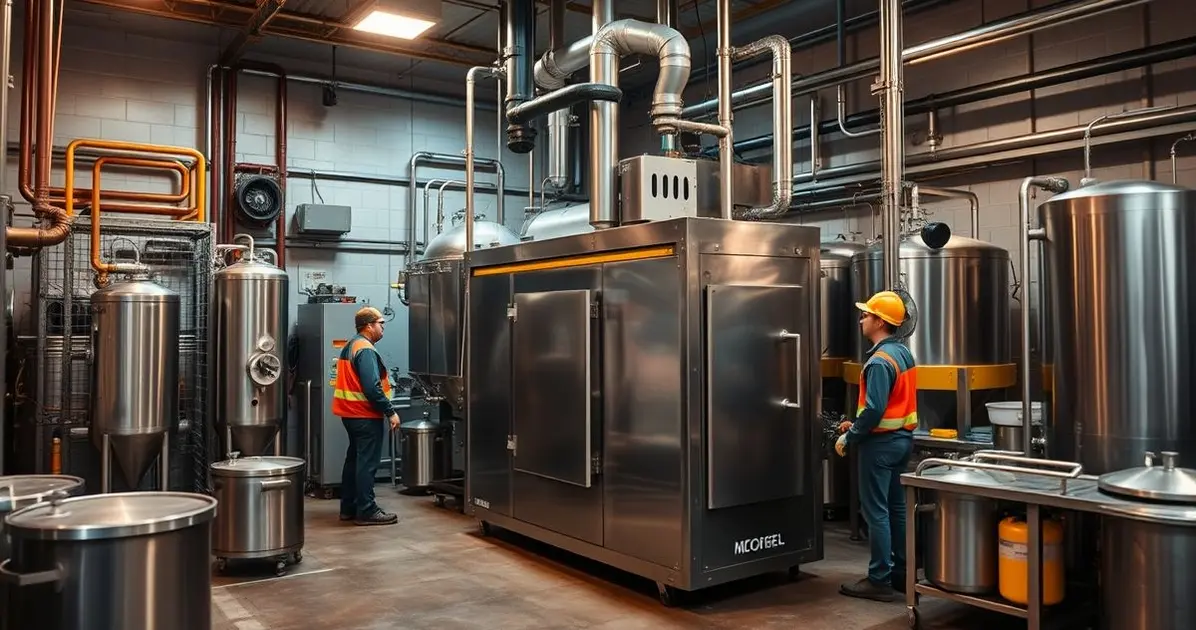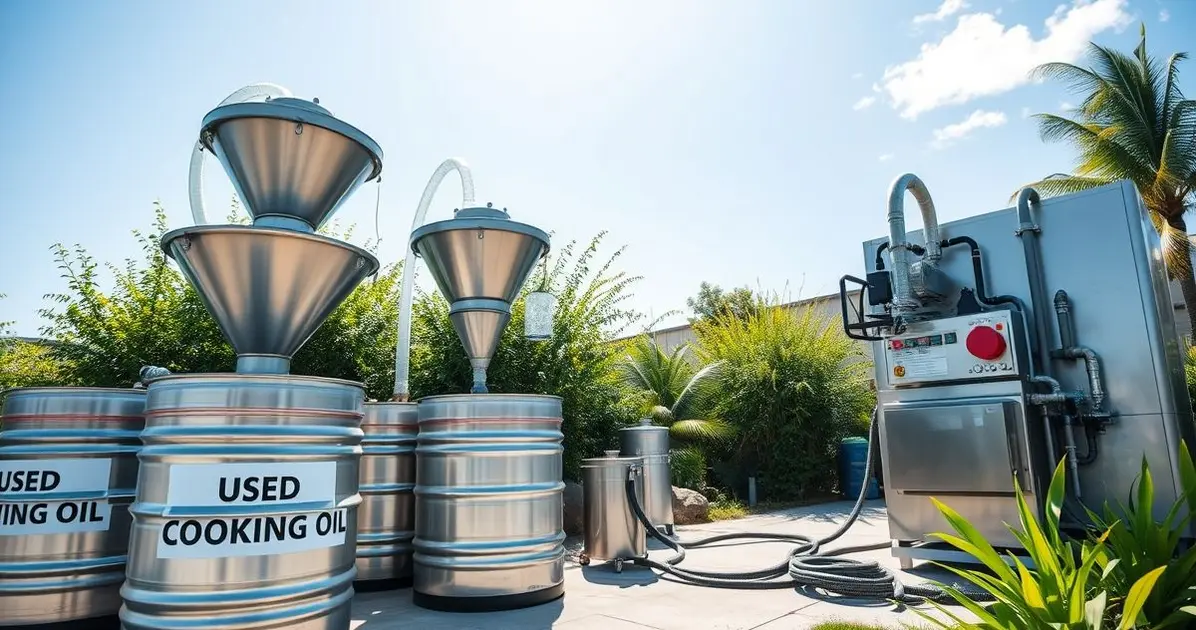Recycling used cooking oil involves specialized tools and equipment to ensure responsible disposal and conversion into useful products like biodiesel. Essential elements include filtration systems, storage containers, and refining units.
What tools and equipment used in recycling cooking oil oil

The recycling of cooking oil utilizes various tools such as filtration systems to remove impurities, storage tanks for collection, and refining equipment to convert the oil into biodiesel. Proper recycling helps reduce waste and promotes sustainability.
Filtration Systems: Purifying Used Oil
When it comes to recycling cooking oil, filtration systems are the unsung heroes of the process. These systems are essential for ensuring that used oil is purified and free from food particles, contaminants, and impurities, making it suitable for further processing.
Filtration systems can vary in complexity, ranging from simple mesh filters to advanced multi-stage filtration units. The choice of system often depends on the volume of oil being processed and the level of purity required. For example, a basic mesh filter can effectively remove larger food particles, while a multi-stage system might incorporate several types of filters, including activated carbon or paper filters, to capture smaller impurities.
Benefits of Filtration Systems
One of the key benefits of using a filtration system is that it helps maintain the quality of the oil. By removing contaminants, the oil is less likely to degrade during the recycling process, which is crucial for producing high-quality biodiesel or other valuable products. Clean oil also leads to better efficiency in subsequent processing steps, ensuring that the final product meets industry standards.
In addition to improving oil quality, filtration systems can also contribute to cost savings. By efficiently purifying used oil, these systems reduce the need for additional processing steps or additives that might be required if the oil were left unfiltered. This not only streamlines the recycling process but also minimizes waste, making it a more sustainable option.
Regular maintenance of filtration systems is essential to ensure their effectiveness. This includes cleaning or replacing filters as needed and monitoring the system for any signs of clogging or malfunction. By keeping the filtration system in top condition, operators can ensure a continuous flow of clean oil ready for the next stages of recycling.
In summary, filtration systems are a critical component in the recycling of used cooking oil. By purifying the oil and removing contaminants, these systems help maintain quality, improve efficiency, and support sustainable practices in the recycling industry.
Heating and Mixing Tanks: Refining Process
Once used cooking oil has been filtered and purified, the next step in the recycling process involves heating and mixing tanks. These tanks play a crucial role in refining the oil, preparing it for conversion into biodiesel or other valuable products.
The primary function of heating and mixing tanks is to provide controlled temperatures that facilitate the breakdown of the oil’s structure. When cooking oil is heated, it undergoes physical and chemical changes that make it easier to process. For instance, heating reduces the viscosity of the oil, allowing it to flow more freely and mix thoroughly with other components during the refining process.
These tanks are typically equipped with precise temperature controls and stirring mechanisms to ensure that the oil is heated evenly. This is important because uneven heating can lead to hot spots that may degrade the oil or cause unwanted reactions. By maintaining a consistent temperature, operators can achieve optimal conditions for the refining process.
Heating and Mixing Tanks: Refining Process
In addition to heating, mixing is another critical aspect of these tanks. During the refining process, the heated oil is often combined with other substances, such as methanol and catalysts, to produce biodiesel through a process called transesterification. The mixing action helps to ensure that these components are thoroughly blended, promoting efficient chemical reactions and maximizing yield.
Safety is also a key consideration when using heating and mixing tanks. Operators must monitor the tanks closely to prevent overheating, which can lead to dangerous situations, such as fires or explosions. Additionally, proper ventilation is essential to dissipate any fumes that may be released during the heating process.
In conclusion, heating and mixing tanks are vital components in the recycling of cooking oil. By providing the necessary heat and agitation, these tanks facilitate the refining process, ensuring that the oil is transformed into high-quality biodiesel or other products. Their role in maintaining safety and efficiency makes them indispensable in any cooking oil recycling operation.

Storage Containers: Safe Handling of Oil
After the cooking oil has been filtered and refined, proper storage is crucial for maintaining its quality and ensuring safe handling. Storage containers are essential in this process, providing a secure environment for the processed oil until it is ready for use or distribution.
One of the primary considerations when selecting storage containers is the material. Containers must be made of materials that are resistant to corrosion and can safely hold the processed oil without reacting with it. Common materials include high-density polyethylene (HDPE), stainless steel, and glass, each offering different advantages in terms of durability and safety.
Proper labeling is another critical aspect of oil storage. Containers should be clearly labeled with information such as the type of oil, date of processing, and any safety warnings. This helps prevent confusion and ensures that anyone handling the containers is aware of the contents and any precautions that need to be taken.
Additionally, secure sealing is vital to prevent leaks and contamination. Containers should be equipped with tight-fitting lids or caps to keep the oil contained and protected from external elements. This is especially important in preventing moisture, dust, or other contaminants from compromising the quality of the oil.
Temperature control is also a factor to consider when storing cooking oil. Ideally, storage containers should be kept in a cool, dark place to prevent degradation caused by heat and light exposure. High temperatures can lead to oxidation, which can spoil the oil and reduce its effectiveness for biodiesel production or other applications.
Regular inspections of storage containers are essential to ensure their integrity. Operators should check for any signs of leaks, damage, or contamination, and take appropriate action if issues are detected. This proactive approach helps maintain safety and quality throughout the storage period.
In summary
storage containers are a critical component in the recycling of cooking oil. By providing safe and secure handling, these containers help preserve the quality of the oil and ensure that it remains suitable for use. Investing in proper storage solutions is essential for any operation involved in cooking oil recycling.
Laboratory Equipment: Quality Testing and Safety Gear
In the recycling of cooking oil, ensuring the quality of the final product is paramount. This is where laboratory equipment comes into play, allowing operators to conduct essential tests that determine the oil’s suitability for biodiesel production or other applications.
Laboratory equipment used in the recycling process typically includes devices for measuring various parameters such as acidity, viscosity, and purity. For instance, a viscometer can be employed to assess the oil’s viscosity, which is crucial for understanding how well it will perform in biodiesel production. Similarly, pH meters are used to measure acidity levels, helping to ensure that the oil meets required specifications.
Another important aspect of laboratory testing is the use of chromatography techniques, which can analyze the composition of the oil. This helps identify any remaining impurities or contaminants that could affect the quality of the final product. By conducting thorough quality testing, operators can make informed decisions about whether the oil is ready for processing or if additional steps are needed.
Laboratory Equipment: Quality Testing and Safety Gear
In addition to quality testing, personal safety gear is essential for workers involved in the recycling process. Handling used cooking oil and the chemicals involved in refining can pose health risks, so proper protective equipment is crucial. This includes gloves, goggles, and masks to protect against harmful fumes or splashes. Ensuring that all personnel are equipped with the necessary safety gear is a vital part of maintaining a safe working environment.
Regular training and safety drills should also be conducted to ensure that workers are familiar with the proper use of laboratory equipment and safety protocols. This proactive approach helps mitigate risks and fosters a culture of safety within the workplace.
In summary, laboratory equipment and safety gear are fundamental components of the cooking oil recycling process. By conducting quality testing and ensuring the safety of workers, operators can maintain high standards for the final product and create a safer working environment. Investing in these resources is essential for any operation focused on recycling cooking oil effectively.
Conclusion
In conclusion, the recycling of cooking oil is a vital process that contributes to sustainability and the production of valuable byproducts like biodiesel. The essential tools and equipment discussed—filtration systems, heating and mixing tanks, storage containers, and laboratory equipment—play crucial roles in ensuring that the recycling process is efficient, safe, and effective.
Filtration systems purify used oil, removing impurities that could compromise quality, while heating and mixing tanks facilitate the refining process, preparing the oil for conversion. Proper storage containers ensure safe handling and maintain the oil’s integrity until it is ready for use. Additionally, laboratory equipment is essential for quality testing, ensuring that the final product meets industry standards, while personal safety gear protects workers from potential hazards.
By investing in these essential tools and adhering to best practices, businesses can not only improve their recycling efforts but also contribute to a more sustainable future. The collective impact of these practices helps reduce waste and promotes the efficient use of resources, making a positive difference in our environment.
FAQ – Frequently Asked Questions about Recycling Cooking Oil
What is the purpose of filtration systems in recycling cooking oil?
Filtration systems purify used cooking oil by removing food particles and contaminants, ensuring the oil is clean and ready for further processing.
How do heating and mixing tanks contribute to the recycling process?
Heating and mixing tanks provide controlled temperatures and agitation, facilitating the breakdown of oil and promoting efficient chemical reactions during refining.
What materials are recommended for storage containers for recycled cooking oil?
Storage containers should be made from materials resistant to corrosion, such as high-density polyethylene (HDPE) or stainless steel, to safely hold processed oil.
Why is laboratory equipment important in the recycling of cooking oil?
Laboratory equipment is used for quality testing to measure parameters like acidity and viscosity, ensuring the recycled oil meets industry standards for biodiesel production.
What safety gear should workers use when handling recycled cooking oil?
Workers should wear gloves, goggles, and masks to protect against harmful substances and fumes during the recycling process.
How can proper storage of recycled cooking oil affect its quality?
Proper storage prevents contamination and maintains oil integrity, ensuring it remains suitable for use or distribution until needed.
See more
Discover plenty of easy and delicious recipes you can make at home, from hearty dinners to indulgent desserts and wholesome breakfasts.




